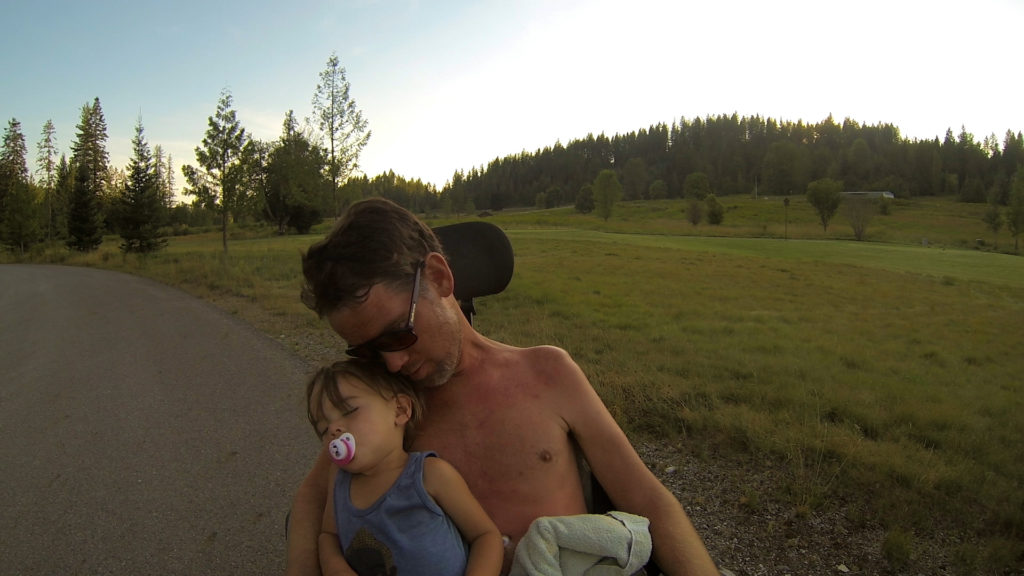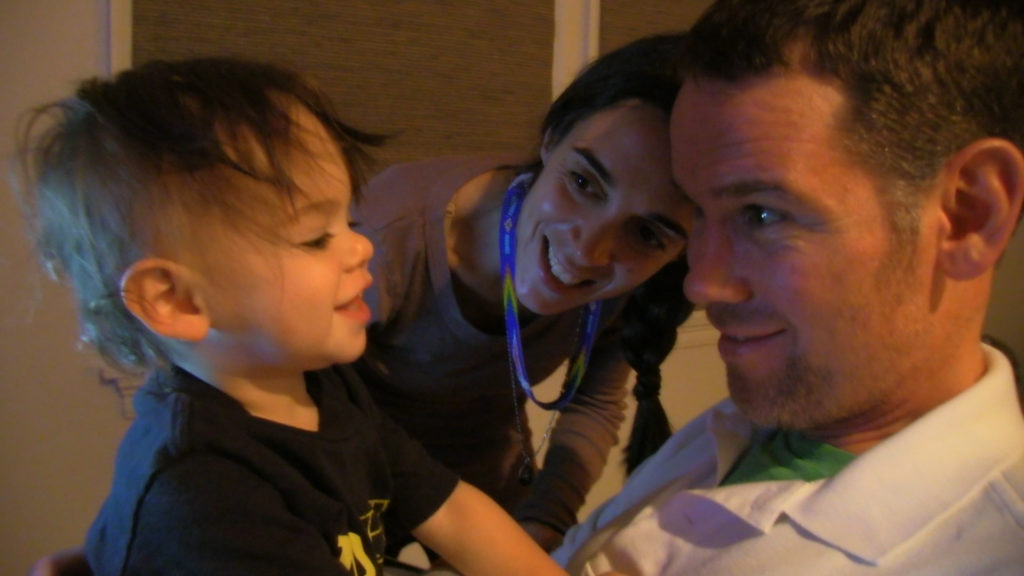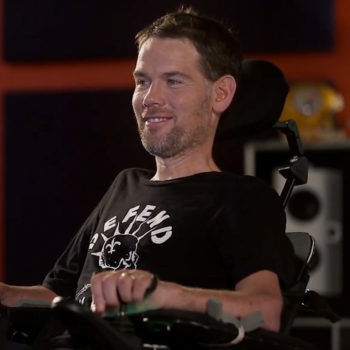NFL star Steve Gleason was a safety for the New Orleans Saints. And he became a hero after blocking a punt in the team’s first home game after Hurricane Katrina. But not long after retiring from the NFL, he was diagnosed with Amyotrophic Lateral Sclerosis, also known as ALS or Lou Gehrig’s disease.
Just six weeks after Gleason’s diagnosis, his wife Michel found out she was pregnant. So Gleason started recording video diaries for his future son. And after taping thousands of hours of footage, the couple called in filmmaker Clay Tweel. He assembled it into a film called “Gleason.” And it’s on the shortlist for a Best Documentary Oscar.
When Brendan met Clay, he asked him what about Steve made him think this doc could be more than a tragic tale about a chronic disease.

Clay Tweel: I think one of the things that stood out to me is that Steve has this quality of what we sort of call like the warrior poet mentality where he was a fierce competitor, somebody who defined himself by his physicality. But also had this existential questioning side of himself.
Brendan Francis Newnam: Yeah. Very cerebral.
Clay Tweel: Yeah, very cerebral and very articulate in being able to voice what he’s feeling as he’s going through it and so, that leads to a very complex person and a very interesting person to follow. Steve and Michel can light up a room. And there’s this sort of energy and quality to them that I wanted to have come across in the movie as well. So while things are certainly sad at times, I think why the movie works is that it also shows the light and it shows the love. You’re able to sort of balance between those two spectrums.

Brendan Francis Newnam: Not to focus on the sad, but I think one of the other things that’s remarkable about the documentary is that you really have some of the most graphic scenes I’ve ever witnessed on film about the toll a disease can take on someone. Tell me about the decision to keep those parts into the movie and did you have to talk with Steve and Michel and did they have video power?
Clay Tweel: It was something very early on that I talked to them about and they said they wanted to show what the daily realities of living with ALS is like. And so, that means getting pretty down and dirty sometimes. And “The Theory Of Everything,” that movie that came out a couple years ago, is great, it’s a fantastic movie, but it doesn’t-
Brendan Francis Newnam: This is the movie about Steven Hawking who also has ALS.
Clay Tweel: Correct. Yeah. And it’s a beautiful movie, but it doesn’t really show like, how hard it would be to get him into bed at night. And they just sort of skip over that so, we wanted to be able to show that. We were showing them cuts to be able to make sure that we were going to test that line, but we would never cross over it.

Brendan Francis Newnam: Yeah. Well, other moments, where they show their vulnerability. Michel is this really powerful character. She’s just had a newborn and he husband is dying. And she’s dealing with both of them. There’s a couple scenes where you’re filming them fighting, which is again, something you don’t really see. And I’m wondering, were you in the room for that? And were, even if you weren’t, when you were looking at that footage, how are you again making that decision about this is heartwrenching and too intimate to put into the movie and the director, who’s like, “I think this needs to be part of our story?”
Clay Tweel: Yeah, there’s some intimate scenes and the fighting, to me, was really getting at what I think is an often overlooked part of stories about illness, which is the care taking side.
It becomes not just about Steve, but about how this illness is affecting the whole family. There’s this scene where they’re in the bedroom and having this fight and Michel, at this point, is just exhausted and she doesn’t have anything left to give, and Steve is sort of questioning why she is-
Brendan Francis Newnam: Extremely needy and kind of pestering her. It’s a little hard to hear right there but Michel is just deflecting Steve and saying, “I don’t know.”
Clay Tweel: That’s one of Michel’s favorite scenes in the movie. Like I showed it to her, and I was certainly worried about the reaction, but she was like, “No, that’s, that was my life. That’s what it’s like.”
Brendan Francis Newnam: Yeah. And also, I think for the viewer it does a service. You’re like, “You can see a ‘Theory Of Everything,’ but it’s just an abstraction.”
Clay Tweel: Yeah. There’s analogy that Michel told me when we were filming that was, I think, really important. She said, “ALS is like this stair step type of disease. You lose a particular skill or motor function and then you adapt your life and you figure out how to live without-“
Brendan Francis Newnam: You like, lose your ability to [use] your legs, you get in a wheelchair.
Clay Tweel: Right, you lost the ability to swallow, so you get a feeding tube. And then you adapt to like life on how to eat and maintain nutrition on a feeding tube, and then you lose something else until you get to the end when there’s really nothing left to lose.
Brendan Francis Newnam: Yeah. Did it take a toll on you going through all this tape? And, I mean, even the moments that make it on film, I was sobbing. Throughout the movie at different points for different reasons.
Clay Tweel: I think it was a very emotional experience, and honestly, I had to sort of put my director hat on and you try to capture that feeling the first time you watch something and then you can become numb to it. But you always want to be able to log that in your brain.
And I think it wasn’t until we were in the sound mix for Sundance and there’s a scene in the movie where Steve goes and he leads this chant right before New Orleans Saints game and the whole stadium is cheering for him. I was watching it playback on the big screen for the first time, and I just started crying. The flood of everything that I had watched and experienced and getting to know these people, like it all kinda came to a head there for me and… actually, the movie is like more emotional for me now than when I was actually putting it together, I think.

Brendan Francis Newnam: So, there’s a timeline throughout the movie where we check in on Steve when he first is diagnosed and I think it takes us all the way up through 2015. How is Steve now?
Clay Tweel: Remarkably, Steve is doing very well. The movie chronicles a lot of his loss of things. And where Steve is in the disease, he’s fully progressed, he can only move his eyes. And so his life is quite regimented, he picks up his son from school almost every day. He still does lunch lady duties once a week at the school and, Steve’s doing whatever he can to make the best use of his time. He’s still kicking ass with his foundation and everything.


